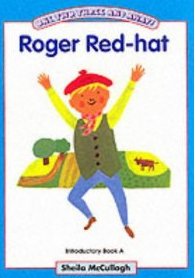An examination of inclusion in UK state schools. This is the title of the paper I am supposed to be writing at the moment. Apparently, I am a little distracted. Too distracted to write with academic criticality. So instead...
Getting Children to Read!

Download my reading chain template here (Google Doc)
Download the pdf here
Every book a child reads, they add a link to their chain
Include an incentive for completion goals
I love reading but...
...in primary school, it was kind of killed for me because I had to read the set texts (lots of Biff and Chips - my poor brother had to trudge through Roger Red-hat - his enthusiasm was killed forever). I was lucky enough to speed through them all in year 3, giving me free rein over the school library for the remaining three years of school. In that time I read five books.
 |
| schoolreading70sbooks.weebly.com |
Don't get me wrong - I really enjoyed reading; I just, sort of, didn't see the point. I enjoyed The Demon Headmaster (way before it was an awesome TV series) and the movie novelizations of Teenage Mutant Ninja Turtles and Hook. I just didn't like the forced nature of primary school reading. Also, I remember being very disappointed that the school librarian had never heard of The Neverending Story, insisting that I was being 'silly'. Grrrr....
Anyway, since I knew I wanted to be a teacher from the age of 7 (I know, I'm a loser, @ me), I vowed that I would change the way children were allowed to read in class.
This isn't rocket science...
... it really isn't. I'm sure you're already letting children read wherever they feel comfortable - on chairs; the wrong way on chairs; under the table; outside (weather permitting)... We've all been in that awkward situation when an important visitor comes into the room just after lunch to find the entire class, adults included, strewn about the place like they have just been tossed in by a gigantic petulant child.
So I'm not going to write about the way we let children read. Instead, I am going to write about how I recorded what they read. Partly because I found myself re-reading old Ofsted reports recently (I'm not a total loser, I'm really not - it was for my MA, I swear!) and my approach was mentioned specifically as something that had 'improved attitudes to reading across the school', but mostly because it is so easy to implement and the benefits are vast.
Reading Chains!
At its simplest, the concept is this:
Children read a book. Children review the book (no more than 50 words). Children get a reward for every five books read.
So many of us do this anyway. Heck, I did this for years before I stumbled across an idea on Pinterest and decided to run with it and make it my own. So what do I do differently?
 |
| i.pinimg.com (Mine are similar to this, but they incorporate written reviews) |
Firstly...
... the reviews are written on slips of paper (see the links in my TL;DR), not in a book. These slips of paper come in 10 different varieties and my rule was that the children can never do the same one twice in a row. These range from a lot of writing to very little but they are all based on the National Curriculum reading criteria.
Next...
... the slips need to be checked for accuracy. In all honesty, I was only concerned with how legitimate the responses were. There was no realistic way to check that the whole book had been read. But it didn't matter. I'll explain why later.
I was working in Year 5 at the time of this particular Ofsted report, so I had some very willing volunteers mark the slips for basic grammar errors (any that weren't unacceptable were forwarded to me for final vetting - this was how I differentiated; it was enough that particular children at all; I didn't want to put them off with grammar).
Then...
... the slips were stapled together to form a paper chain, which was displayed on a wall under a sticker that the children had decorated with their own name.
That's it. That's the whole thing.
Oh, and also...
... incentives. For every five successful links in the chain (review slips would be unsuccessful if they were badly written; had no name; or simply weren't full enough. Again, all suspect slips were forwarded to me by my helpers), the child got to take a prize from my BAG OF CRAP!!! They only got 5 seconds, to preserve the prestige and mystery of the bag's contents. This was enough.
 |
| www.jeweltailor.com |
The Bag of Crap has had its detractors. I have heard people say 'you shouldn't have to bribe children into reading' and the like. To these people I say: you're right. But no-one does something for nothing. I don't see it as bribery, I see as encouragement. My end goal is to get these children, even the reluctant ones, to read. This works.
Terms and Conditions apply...
... for upper KS2 (9-11 yrs), I insisted that the books had to be either ten chapters long or at least 100 pages. They were welcome to read anything else (Dr Suess book were very popular) and could even approach me with a deal (five mini-books, totalling 100 pages gained them one reading slip - I'm not a monster!) but if they wanted to earn a link their chain, thems were the rules.
I also insisted on a minimum number of links per 6-week term. I figured that, with the expected 20 minutes of reading every night for homework, and an average of one hour of dedicated reading time in school, they should get through at least one full book every two weeks.
Did this help me as a teacher?
You bet it did. I had a visual record of my class's reading achievement. I could tell, at a glance, who was excelling and who was falling behind. If I suspected some inconsistencies, I would ask for the child to read to me to five minutes to assess the level of books they were reading. If children were eating up books from the school library, I brought in more challenging books from home. And it worked. Everybody was reading more than they ever had. Best of all, when it came to the end of the school year, the children wanted to wear their reading chains as scarves.
Full disclosure...
... I coupled this with a very strict home-reading regimen. Every day I would expect to see that the children had read at home. I would need pages from and to, coupled with an adult's signature. If this was missing for more than two days in a week, there were consequences. There were also times when I had to speak with parents about the importance of listening to their child read. I was pretty lenient, I accepted reading to a sibling as independent reading. For this to work, I needed to rely on my amazing TA. Luckily, she was fully on board and asked for her own reading chain to be displayed!
Whole school?
Yup. I established it in my class for a term, to ensure that I had ambassadors who could go to other classes and show them how to do things, even do the checking and stapling for a few weeks.
After my class, I went for the most enthusiastic teacher, who was in Year 2 (6-7 yr olds). It's a scheme that takes a bit of effort so there is no point going after nay-sayers right away; you need some traction first. The combination of the Y2 teacher's enthusiasm, my ambassadors, and the novelty of coming to my classroom to receive their prize (I was responsible for prizes for the whole school - this way I could keep an informal track on which year groups were reading and which weren't!) meant that by the end of the Spring Term, Reading Chains were established in Years 2 and 5. I then introduced it to Year 4. This was a slightly resistant class for various reasons but since my class was running itself by now, I could co-run it in Year 4.
This worked out great because it meant that the following school year, the classes I had missed would inherit children who were already invested in the scheme. It really didn't take long for it to become second-nature to every child. And, like I said, Ofsted loved it.
The links for my templates are above - feel free to download and adapt as you see fit. Thanks for reading this - now I really have to go and write that paper. Sigh. I hope you're all having a great time - the evenings are getting a little brighter bit by bit! I would like to leave you with a poem that one of my 9-year-olds wrote last week:
The moon is a stubborn dog,
Grabbing, gripping, grappling,
Tearing apart the light
Day by day
Until
There's nothing.
But then,
Bit by bit,
Bite by bite,
The light... comes back.
I love teaching poetry. Maybe that'll be next week's focus? Have fun, y'all!

Carl Headley-Morris
@Mr_M_Musings tragiclantern@gmail.com bit.ly/carlslearningplace

Comments
Post a Comment